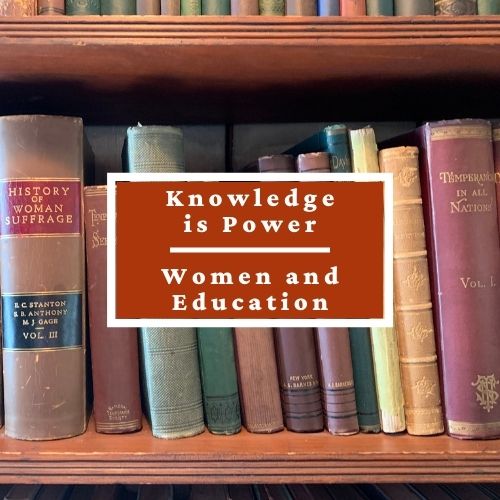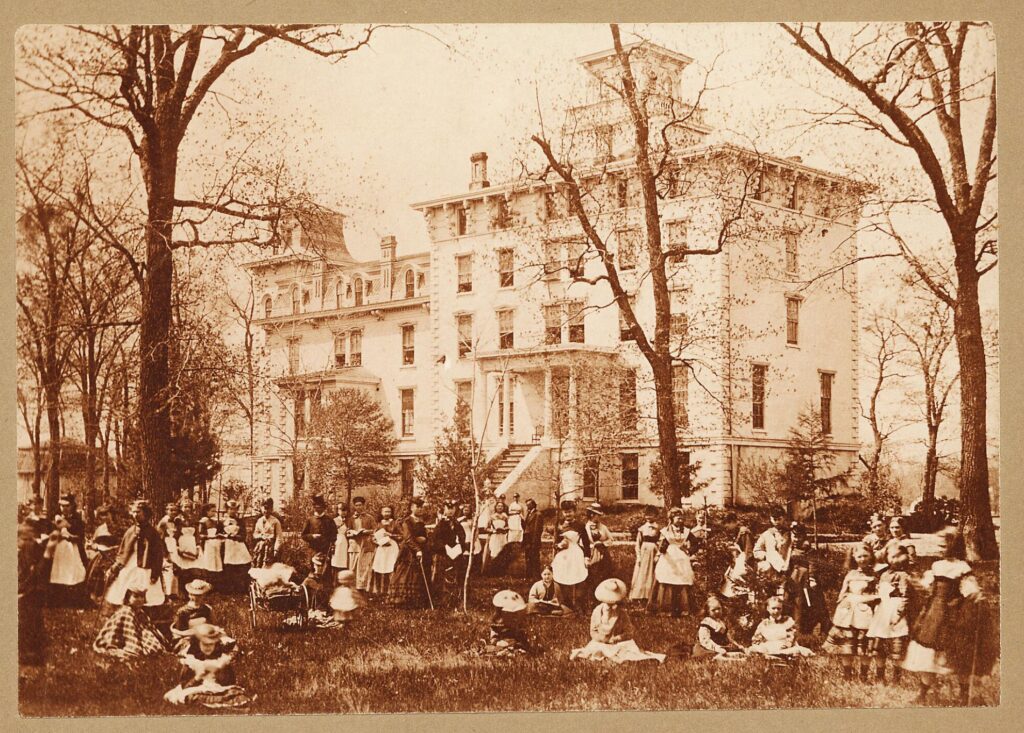By Lori Osborne, Evanston Women’s History Project Director
150 years ago, Evanston was at the center of an experiment in education that would define it for generations. Though Northwestern University is the best known today, it was two small women’s colleges that established Evanston as “a paradise for women.”1 As we start the school year in 2022, a look back at this time can bring surprising insight and deeper appreciation for those early explorers in the new world of higher education for women.

The Beginnings of Women’s Education in the U.S.
First, a very brief background.2 In the early 19th century, an emphasis on creating a literate and informed citizenry in the young American democracy led to new ideas about public education. This was also true for higher education, resulting in the first small colleges that were not just for wealthy young men pursuing a classical education or joining the ministry.
Although the intended recipients of this enhanced education were white men, ideas about (white) women’s education also began changing. Since women were the primary caregivers for their children, women’s education began to be seen as essential to the development of their children (especially their sons) as citizens. Meanwhile, as the need for public education increased with the growth of the U.S. population and its expansion into the western territories, young educated women also came to be considered the best source for new school teachers. Women also began to clamor for an education equal to that of their brothers.
In 1837, two schools provided models for the higher education of women. That year, Mount Holyoke Female Seminary was founded in Massachusetts to offer an equal and advanced curriculum for women. In addition, it offered a co-op plan to help women afford the cost. And Oberlin College, in Ohio, opened its classes to women, becoming the first coeducational college in the U.S.
Following Mount Holyoke’s lead, many similar “fem-sems” were initiated in the Eastern states. In 1844, Illinois saw the start of its first true college for women, the Rockford Female Seminary, which was connected to the Congregational Church. In this same time period, Catharine Beecher (Harriet Beecher Stowe’s sister) toured the Midwest, calling for American women to step up to the challenge of educating the next generation. Rockford Seminary was followed by Jacksonville Female Seminary in 1848, and Peoria Female Seminary in 1853—both Methodist-affiliated schools.
Women’s Education and Evanston
By the mid-1850s, Evanston, Illinois, was making its mark on higher education. The Methodist founders of Northwestern University purchased land on the shores of Lake Michigan in 1853, and the new town and campus was mapped out soon after. In fall, 1855, three institutions of higher learning opened their doors. Two of them—Northwestern University and Garrett Biblical Institute—saw their first classes of male students, but for our purposes it is the third institution that is most interesting: the North-Western Female College welcomed eighty-four young women who had enrolled in the new school.

The North-Western Female College (NWFC) was located at the southwest corner of Lake and Chicago Avenues in Evanston—just two blocks from the University’s first building at Hinman and Davis. NWFC was founded by Rev. William Jones, a Methodist minister, who had been a clerk in Abraham Lincoln’s law office in Springfield before briefly serving as Principal at Peoria Female Seminary. After encouragement from Methodist leaders, Jones brought his ideas for female education to Evanston. The new school was funded by Jones’ brother Wesley, who had made money in the California Gold Rush. The brothers were born in Philadelphia, the sons of a Methodist minister; and both had attended Methodist colleges. They toured East Coast schools and discussed women’s education with like-minded men—two of whom went on to found Vassar and Wellesley colleges. The Jones brothers acquired land in Evanston, and chartered and built the new school. In 1857, William Jones married Mary Hayes, educated at Mount Holyoke, who had been hired as Principal of the NWFC.
Early on, there was some tension between the university founders and the NWFC; the women’s college gained a lot of attention and attracted many more students in its early years: the University had only ten students in 1855, and remained very small until after the Civil War. The similarity of the names probably did not help. But when the NWFC’s building burned down within a year of opening, the University and its Trustees offered emergency help and support.
Like most women’s “colleges” at the time, the NWFC was the equivalent of an advanced high school or preparatory school. Still, it offered a rigorous curriculum, very similar to the University’s—a mixture of classical and scientific courses, including literature, natural sciences, grammar, mathematics, and history, along with “ornamental” courses in French, German, music, and drawing. However, the NWFC could not grant a college degree; its graduates received “laureates.” Students were required to attend church services on Sundays and take a 30 minute walk each day (accompanied of course). Students at the college published Evanston’s first printed newspaper – The Casket and Budget – in 1858 (Frances Willard was its first editor). It was also home to Evanston’s first women’s literary club, the Minerva Society, also headed by Frances Willard.
It was the North-Western Female College that drew Frances Willard and her sister Mary from Wisconsin in the spring of 1858, and from which they both would graduate. Willard was in the first graduating class of the college in 1859 (a class of two) – and the experience of her education there and residence in a town that clearly valued and promoted higher education for women would impact her life dramatically. The NWFC remained a viable institution for the first sixteen years of Evanston’s history, closing in 1871 as education for women advanced and Northwestern University finally admitted women—but that’s another story which will be covered in a later blog post.
The Evanston Women’s History Project is partnering with the Frances Willard House Museum and WCTU Archives to tell the story of women and education in Evanston. For more on Frances Willard and her connection to this story, visit www.franceswillard house.org.
[1] Frances Willard. Glimpses of Fifty Years, p. 199.
[2]Andrea Turpin. A New Moral Vision: Gender, Religion, and the Changing Purposes of American Higher Education, 1837-1917. Much has been written about this topic, but a focus on women, education and religion makes Andrea Turpin’s book most helpful for our story, though she does not include Evanston.
